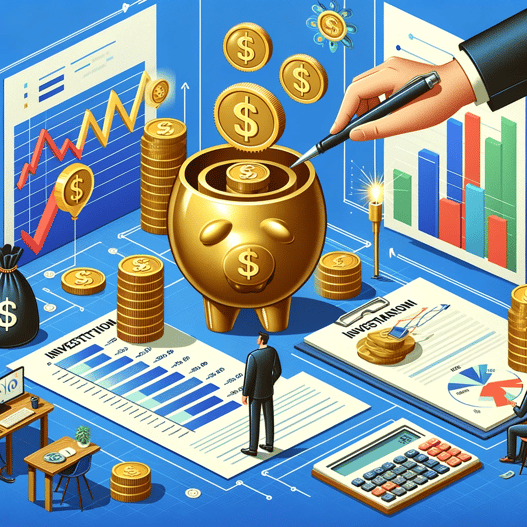Explore the multifaceted impact of inflation on business operations in our comprehensive article. Delve into how rising costs, pricing strategies, supply chain disruptions, and employee morale are influenced by inflation. Learn about effective adaptation strategies for businesses to navigate these economic challenges and thrive. Essential reading for entrepreneurs and business professionals seeking to understand and respond to inflationary pressures.
Introduction
In an ever-evolving economic landscape, one of the constants is the challenge of inflation. This economic phenomenon, often a headline topic in financial news, goes beyond just being a buzzword—it's a pivotal factor that can significantly sway the course of business operations. Understanding inflation, therefore, is crucial for entrepreneurs, business leaders, and even consumers seeking to navigate the complexities of the market.
What is Inflation?
At its most basic, inflation represents the rate at which the general price level of goods and services in an economy rises over a period, leading to a decrease in the purchasing power of money. It's akin to the gradual erosion of the monetary value, where a dollar today might not hold the same value tomorrow. Inflation occurs due to various reasons—increased production costs, higher demand than supply, or expansive monetary policies, among others.
Inflation's Multifaceted Impact on Businesses
The repercussions of inflation are diverse and multifaceted in the business world. It's not just about the increased costs of raw materials or services, but a broader spectrum of challenges. Inflation can affect everything from pricing strategies, wage demands, consumer purchasing power, investment decisions, and overall business growth.
For businesses, navigating inflation is akin to steering a ship in turbulent waters. Prices for raw materials may rise, increasing production costs and squeezing profit margins. The domino effect continues as businesses are then faced with the dilemma of increasing their prices, which can lead to decreased demand and customer dissatisfaction.
Moreover, inflation also impacts the workforce. Employees, facing higher living costs, may demand increased wages, adding to the financial strain on businesses. This scenario can lead to a complex balancing act between maintaining employee satisfaction and controlling operational costs.
From an investment perspective, the unpredictability brought on by inflation can make strategic planning a challenge. Uncertainties in costs and market conditions can lead to deferred investments or even scaling back on expansion and innovation initiatives.
In this blog post, we delve deeper into each of these areas, exploring how inflation impacts business operations and what strategies can be employed to navigate these challenges effectively. Understanding these dynamics is not just beneficial but essential for businesses to thrive in an inflationary economic climate.
 Understanding Inflation
Understanding Inflation
To navigate the challenges inflation poses to business operations, it's essential first to understand what inflation is, its root causes, and the different types it manifests as. This understanding provides a foundational perspective for businesses to strategize and adapt accordingly.
Definition of Inflation
Inflation is the rate at which the general level of prices for goods and services is rising in an economy, subsequently leading to a decrease in the purchasing power of a currency. It's measured as an annual percentage increase. As inflation rises, every dollar you own buys a smaller percentage of a good or service.
Causes of Inflation
The causes of inflation are diverse and often interconnected. They can be broadly categorized into three main groups:
1. Demand-Pull Inflation: This type occurs when the demand for goods and services exceeds their supply in an economy. It can happen due to increased consumer spending, government expenditure, or investment. When more money chases fewer goods, prices naturally rise.
2. Cost-Push Inflation: This form of inflation arises from an increase in the cost of production. Factors like higher raw material costs (due to shortages or increased demand), rise in labour costs, or more expensive manufacturing processes can lead to businesses increasing their prices to maintain profit margins.
3. Built-In Inflation: Also known as wage-price inflation, it's the result of a repetitive cycle of wage increases. Workers demand higher wages as living costs rise due to inflation. Businesses then pass these increased labor costs onto their customers in the form of higher prices, leading to a spiral effect.
Each type of inflation has different implications for business strategy and operations. Recognizing the type of inflation at play can guide businesses in making more informed decisions, whether it's about pricing, supply chain management, investment, or wage policies.
Impact on Business Costs
Inflation's grip on the economy invariably extends to the business sector, influencing both operational and strategic aspects. One of the most palpable effects of inflation is on the costs that businesses incur. These increased costs can emerge in various forms, from the price of raw materials to the expenses related to production and supply chain management.
Increased Costs of Goods and Services
When inflation rises, it often leads to an increase in the prices of goods and services. This rise can be due to multiple factors, such as higher costs of raw materials, increased labor costs, and more expensive utility expenses. For businesses, this translates to more costly inputs—whether it's the raw materials used in manufacturing, the services required for operation, or the basic essentials like electricity and water.
For instance, a manufacturer relying on steel and plastics might face increased costs as these raw materials become more expensive due to inflationary pressures. Similarly, a service-oriented business may encounter higher costs for software subscriptions or consulting services that are essential to its operations.

Impact on Supply Chain and Production Costs
Inflation also significantly impacts the supply chain and production costs. It's not just the price of raw materials that increases; there are cascading effects throughout the supply chain. Transportation costs, for instance, can spike due to increased fuel prices, leading to higher expenses in delivering products to the market.
Moreover, inflation can lead to wage increases as employees seek compensation that keeps pace with the rising cost of living. For businesses, this means higher labor costs, which can be particularly impactful in labor-intensive industries.
Additionally, there's the aspect of global supply chains. For businesses that rely on imported goods or components, currency devaluation linked to inflation can make imports more expensive, further compounding the cost increases.
These inflation-induced cost hikes force businesses to reevaluate their operational efficiencies and cost structures. They might need to look into alternative suppliers, renegotiate contracts, or find ways to streamline operations to reduce expenses. In more severe cases, businesses might need to reconsider their production strategies, potentially scaling back production or exploring automation to cut costs.
Effect on Pricing Strategies
In an inflationary environment, businesses are often compelled to reevaluate and adjust their pricing strategies. This necessity stems from the need to balance the increased operational costs with customer retention and market competitiveness.
Adjusting Prices to Cope with Inflation
The most direct response to inflation for many businesses is adjusting their prices. This adjustment is crucial to ensure that the rising costs do not erode profit margins. However, this is not a straightforward process. The challenge lies in determining how much of the increased cost can be passed on to the consumer without adversely affecting demand.
Businesses must conduct market research to understand the price elasticity of their products or services. Some markets may bear a higher price increase than others. For example, luxury goods with fewer substitutes might withstand higher price increases than commoditized products where customers can easily switch to cheaper alternatives.
Another factor to consider is the timing and frequency of price adjustments. Frequent price changes can lead to customer dissatisfaction and confusion. Hence, businesses need to find the right balance between making necessary adjustments and maintaining pricing stability.
Balancing Customer Retention and Profit Margins
The art of pricing in an inflationary period also involves maintaining a delicate balance between retaining customers and safeguarding profit margins. Significant price increases may drive customers to seek alternative products or services, especially in highly competitive markets.
To mitigate this risk, businesses can explore strategies such as introducing tiered pricing, offering discounts or loyalty rewards, or bundling products and services to provide added value. These strategies can help soften the impact of price increases on customers and can encourage customer loyalty and retention.
Moreover, transparent communication about price changes can also play a crucial role in maintaining customer trust. Businesses that openly communicate the reasons behind price increases, such as rising raw material costs, can often maintain better customer relationships compared to those that implement changes without explanation.
In essence, effective pricing strategies during inflationary times require a nuanced understanding of the market, the competitive landscape, and customer behavior. By carefully balancing these factors, businesses can navigate through the challenges posed by inflation without significantly compromising on their customer base or profit margins.

Impact on Employee Wages and Morale
Inflation not only affects the external aspects of a business, such as costs and pricing but also has significant internal implications, particularly in relation to employee wages and morale. Understanding and addressing these issues is crucial for maintaining a productive and engaged workforce.
Need for Wage Adjustments
One of the most immediate internal impacts of inflation is the need for wage adjustments. As the cost of living rises, employees naturally expect their salaries to increase accordingly to maintain their purchasing power. Failure to adjust wages in line with inflation can lead to a host of issues, including employee dissatisfaction, increased turnover, and difficulties in attracting new talent.
For businesses, this poses a dilemma. While it’s important to keep employees satisfied and financially secure, significant wage increases can add to the already rising operational costs. This challenge requires careful balancing, taking into account the business's financial health and the competitive wage landscape in the industry.
Effects on Employee Satisfaction and Productivity
The effects of inflation on employee satisfaction and productivity are profound. When employees feel that their wages are not keeping pace with the rising cost of living, it can lead to decreased morale and engagement. This dissatisfaction can manifest in reduced productivity, lower quality of work, and an increase in absenteeism and turnover rates.
Conversely, fair and timely wage adjustments can boost employee morale and loyalty. Employees who feel valued and fairly compensated are more likely to be engaged, motivated, and committed to the organization’s success. This positive work environment can lead to increased productivity, better customer service, and overall improved business performance.
Balancing wage adjustments with business sustainability during inflationary periods is a complex task. It may involve creative compensation strategies, such as performance-based bonuses, additional non-monetary benefits, or flexible work arrangements. Regular communication with employees about the company’s financial position and compensation policies can also help in managing expectations and maintaining trust.
Effects on Investment and Growth
Inflation not only influences day-to-day business operations but also plays a critical role in shaping a company’s long-term strategies, particularly in the areas of investment and growth. Navigating these challenges requires foresight, flexibility, and strategic planning.
Challenges in Long-term Planning and Investment
Inflation introduces a degree of uncertainty and complexity into long-term planning and investment decisions. With the future cost of resources, labor, and capital becoming more unpredictable, businesses face difficulties in accurately forecasting their expenses and returns. This uncertainty can lead to more conservative investment strategies, potentially slowing down growth.
For instance, a company may hesitate to commit to large capital expenditures, such as purchasing new equipment or expanding facilities, if it is uncertain about the future cost implications. Similarly, inflation can affect the cost of borrowing, as interest rates often rise in response to inflation, making loans and financing more expensive.
Impact on Expansion and R&D
Inflation can particularly impact a company’s expansion plans and its investment in research and development (R&D). Expansion usually requires significant upfront investment, and in an inflationary environment, the costs associated with expanding operations, such as leasing or building new facilities, hiring additional staff, and marketing, can escalate quickly.
Investment in R&D is often one of the first areas to be impacted in times of financial strain. While R&D is crucial for innovation and long-term growth, it requires substantial funding and does not always provide immediate returns. During periods of high inflation, companies might scale back on R&D spending to focus on more immediate financial concerns, potentially hindering future innovation and competitiveness.
To mitigate these challenges, businesses may need to explore alternative financing options, focus on operational efficiencies, or adjust their growth strategies to be more incremental and adaptable. It's also important for businesses to maintain a long-term perspective, balancing immediate economic pressures with the need for ongoing investment in growth and innovation.
 Adapting to Inflation
Adapting to Inflation
In an economic environment characterized by inflation, businesses cannot remain passive. Adapting to these conditions requires proactive strategies, emphasizing flexibility and innovation, to mitigate the adverse effects of inflation and capitalize on any emerging opportunities.
Strategies for Businesses to Mitigate Inflation Effects
Businesses can employ several strategies to combat the challenges posed by inflation:
1. Diversifying Suppliers: Relying on a single supplier for raw materials or components can be risky, especially if inflation affects certain regions or industries more than others. Diversifying suppliers helps reduce this risk and may provide more competitive pricing options.
2. Efficiency Improvements: Streamlining operations to improve efficiency can help offset the impact of rising costs. This might involve investing in new technologies, optimizing supply chain management, or implementing lean manufacturing principles.
3. Flexible Pricing Strategies: Developing a pricing strategy that allows for adjustments in response to changing costs can help maintain profit margins without alienating customers. This could include dynamic pricing models, tiered pricing structures, or bundled offerings.
4. Hedging against Price Fluctuations: Some businesses may benefit from financial instruments like futures contracts to hedge against price fluctuations in essential commodities or currencies.
5. Maintaining Strong Cash Reserves: Having robust cash reserves can provide a buffer against the impact of inflation, allowing businesses to manage short-term financial challenges more effectively.
Importance of Flexibility and Innovation
Flexibility and innovation are paramount in an inflationary environment. Businesses that can quickly adapt to changing conditions and find creative solutions to the challenges posed by inflation are more likely to thrive.
Flexibility might involve being open to changing business models, exploring new markets, or adapting product lines in response to shifting consumer preferences and cost structures. Innovation, on the other hand, can help businesses find new and more cost-effective ways of delivering value to customers. This could involve investing in research and development, embracing new technologies, or innovating in business processes and customer service.
Ultimately, the businesses that succeed in an inflationary environment are those that view these challenges not just as obstacles to be overcome, but as opportunities to evolve and grow. By being proactive, flexible, and innovative, businesses can not only mitigate the negative impacts of inflation but also position themselves for long-term success.
Conclusion
Inflation presents a complex and multifaceted challenge for businesses, affecting various aspects of operations, from costs and pricing to employee wages and long-term growth strategies. As we have seen, inflation can lead to increased business costs, compel adjustments in pricing strategies, impact employee morale and wages, and create uncertainties in investment and expansion plans.
However, it's important to recognize that while inflation poses significant challenges, it also presents opportunities for businesses to reassess, innovate, and adapt their strategies for sustained success. The key lies in being proactive and responsive to the changing economic landscape.
Businesses that anticipate and plan for inflationary pressures are better positioned to manage the associated challenges effectively. Strategies such as diversifying suppliers, improving operational efficiencies, adopting flexible pricing strategies, and maintaining robust cash reserves can help mitigate the adverse effects of inflation.
Moreover, embracing flexibility and innovation is crucial. Inflationary periods can catalyze businesses to explore new markets, innovate in products and services, and refine their business models to remain competitive and relevant.
In conclusion, while navigating the impacts of inflation requires careful planning and adaptation, it also offers an opportunity for businesses to strengthen their operations and strategies. By being proactive, flexible, and innovative, businesses can not only weather the challenges posed by inflation but also emerge stronger and more resilient in the face of economic uncertainties.



